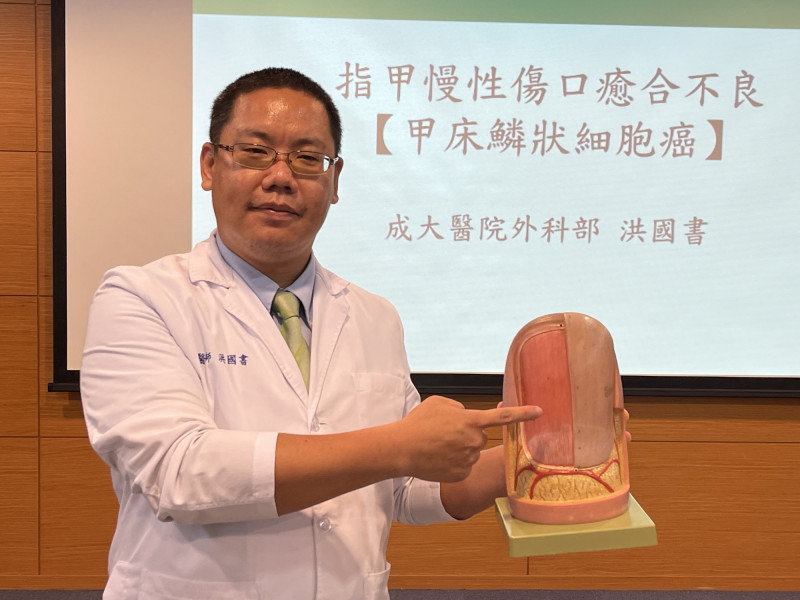Dr. Hong Guoshu of the Department of Surgery of Chengda Hospital pointed out that if the nails have chronic wounds that have not healed well for more than six weeks, they should seek medical treatment as soon as possible.
(Photo by reporter Wang Junzhong)
[Reporter Wang Junzhong/Tainan Report] Mr. R, an American who has lived in Taiwan for many years, found a black spot under the nail of his right little finger two years ago. And remove the black spots; but the nail wound has not healed, and was referred to the dermatology department of Chengda Hospital for medical treatment. The wound section was examined for skin pathological staining, and the result was a rare squamous cell carcinoma of the nail bed, which was treated by plastic surgery.
Hong Guoshu, a traumatologist at Chengda Hospital, said that the most complete treatment of Mr. R's lesion should be to remove the entire knuckle of the right little finger by surgery, but this has a great impact on Mr. R, who needs to type for a long time at work.
After discussion between the doctor and the patient, it was decided to remove the entire nail bed and surrounding skin.
Please read on...
Mr. R, an American who lives in Taiwan, has a small black spot on his right little finger that has not disappeared for half a year. After the excision, the wound has not healed. After examination, it is a rare nail matrix cell carcinoma.
(Provided by Chengda Hospital)
The pathologist then confirmed that there were no malignant tumor cells around the resected tissue by means of frozen section; the surgeon continued to transpose the dorsal tissue of the middle phalanx of the ring finger to cover the wound at the resected part of the little finger, and performed the "reverse interdigital flap reconstruction" operation. Performed under local anesthesia and completed in 2 hours.
Two weeks later, Mr. R underwent local anesthesia for skin flap separation and skin grafting. Healed well, and he continued to follow up for recurrence in the dermatology clinic.
Hong Guoshu pointed out that squamous cell carcinoma of the nail bed accounts for a very low proportion of malignant skin tumors, but it is the most common malignant tumor in the surrounding tissues of the nail.
According to the statistics of the United States in recent years, squamous cell carcinoma of the nail bed occurs in men aged 50-70, and the most common sites are the thumb and big toe.
This cancer is easily confused with viral warts, pyogenic granuloma, onychomycosis and chronic paronychia, resulting in delayed diagnosis.
If the nail has a chronic wound that has not healed for more than 6 weeks, it is a warning sign and you should seek medical attention as soon as possible.
Hong Guoshu said that surgical resection is the first-line treatment for nail bed squamous cell carcinoma. It must take into account the complete resection of the lesion and the functional requirements of the hand to achieve a win-win goal. However, if it is a relatively advanced squamous cell carcinoma, it may need to be combined with radiation treatment and other adjuvant therapies.
Mr. R, an American who lives in Taiwan, has a small black spot on his right little finger that has not disappeared for half a year. After the excision, the wound has not healed. It was found to be a rare nail bed squamous cell carcinoma. The doctor performed reverse interdigital flap reconstruction to help it heal.
(Provided by Chengda Hospital)
☆Health news will never be missed, click like to follow the fan page.
☆For more important medical news, please go to Liberty Health.com.
keywords
skin cancer
malignant tumor
nail
squamous cell carcinoma
related news
